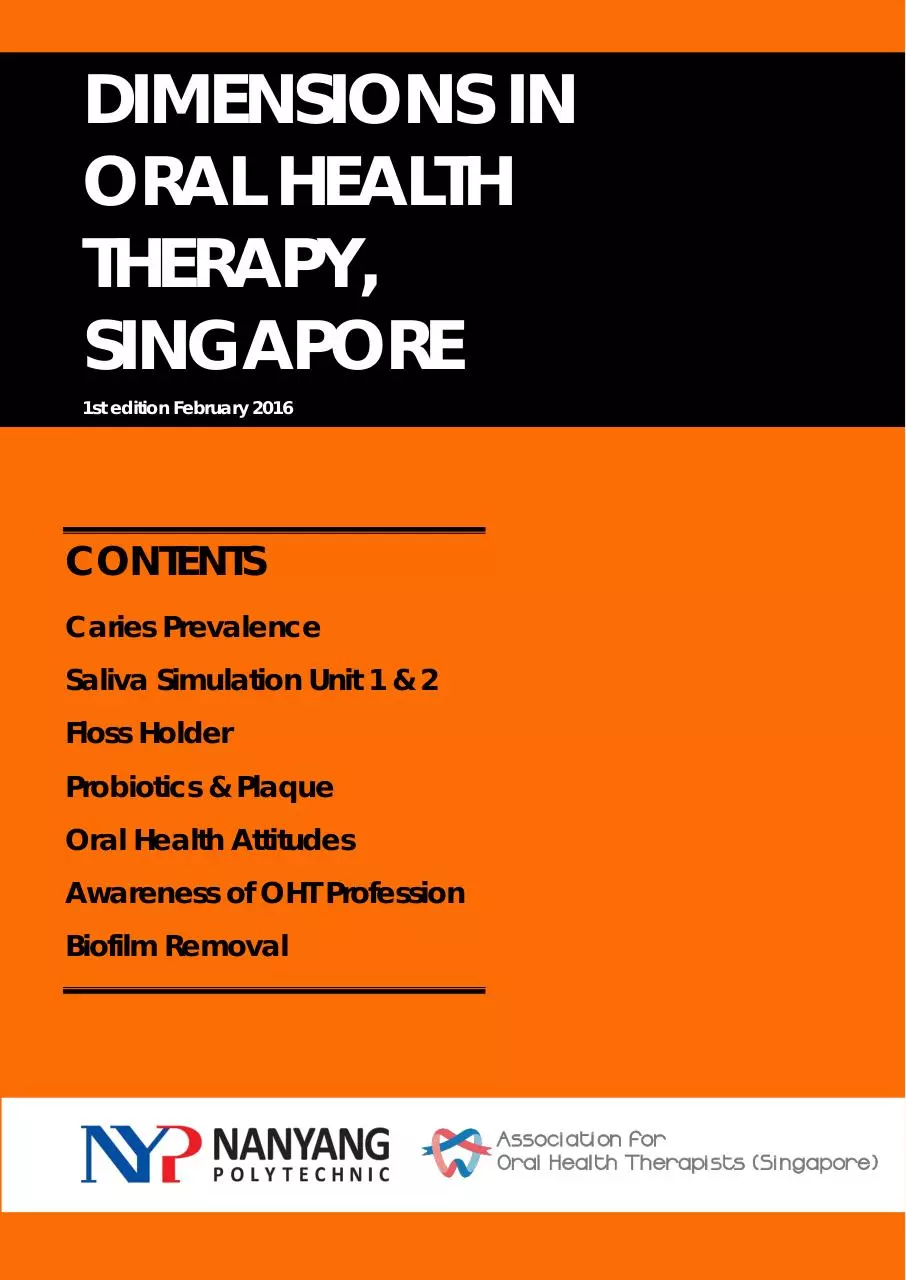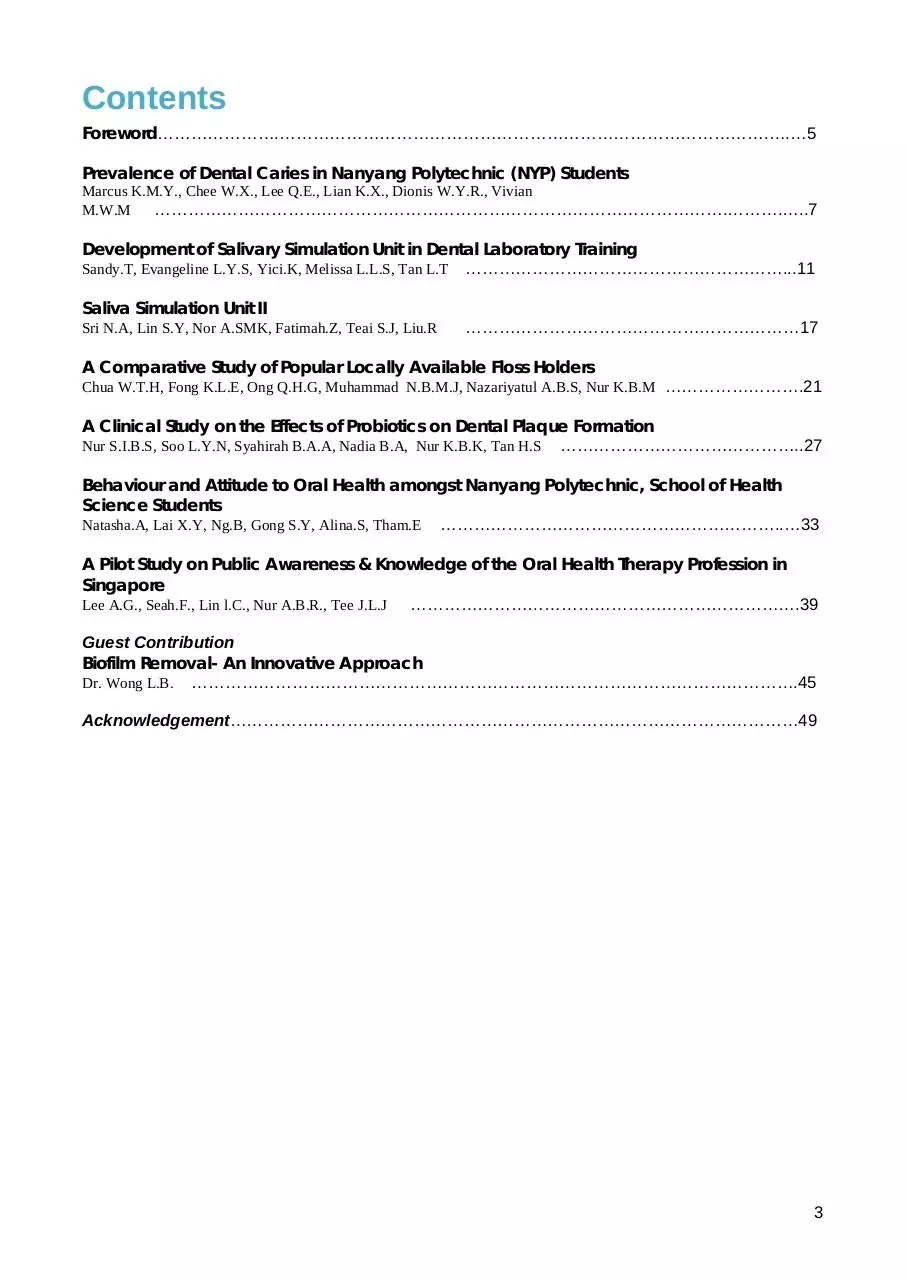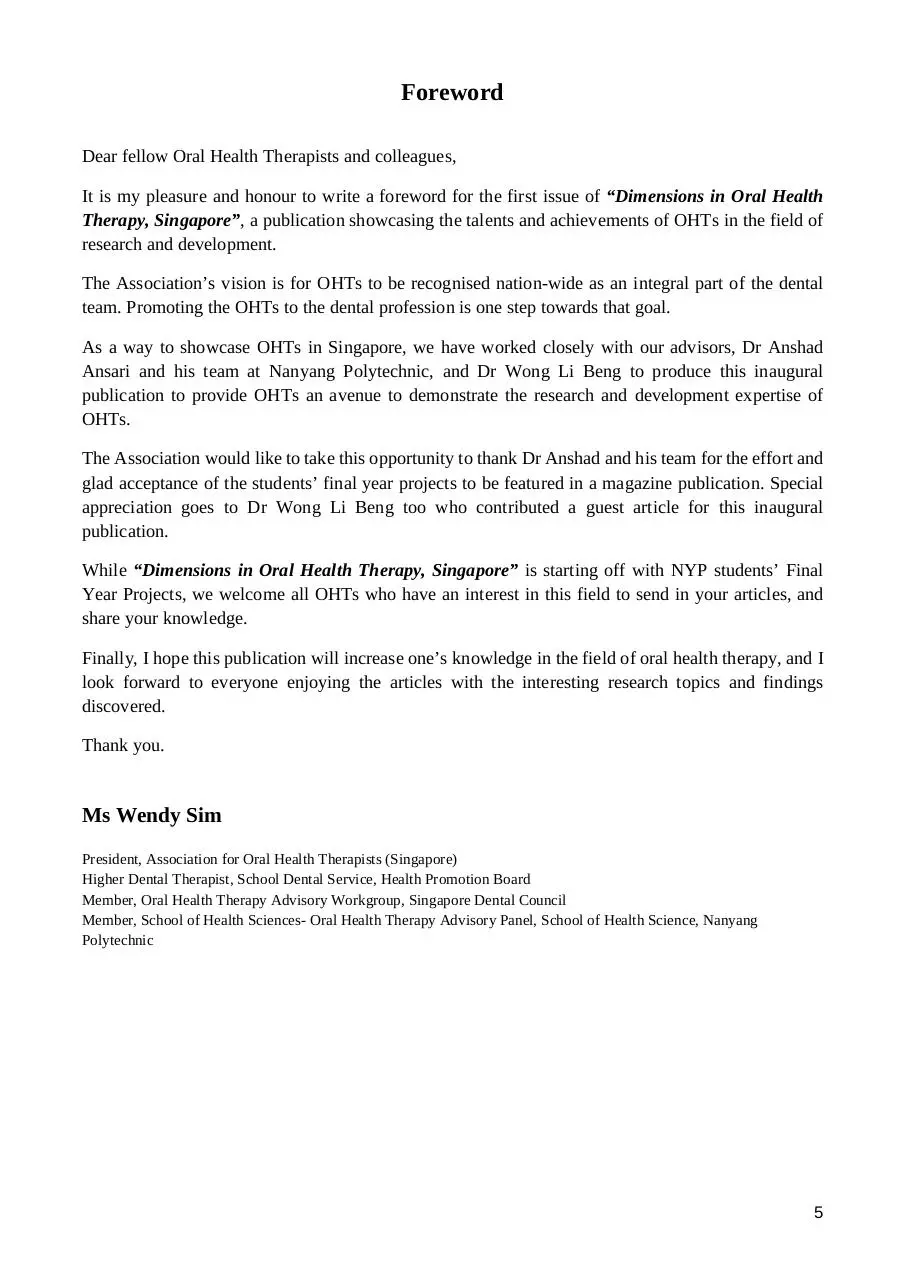Draft Dimensions in Oral Health Therapy(Singapore) (PDF)
File information
Title: Dimensions of
Author: Jenny Mace
This PDF 1.5 document has been generated by Acrobat PDFMaker 15 for Word / Adobe PDF Library 15.0, and has been sent on pdf-archive.com on 15/08/2016 at 14:12, from IP address 180.255.x.x.
The current document download page has been viewed 2265 times.
File size: 1.97 MB (50 pages).
Privacy: public file





File preview
DIMENSIONS IN
ORAL HEALTH
THERAPY,
SINGAPORE
1st edition February 2016
CONTENTS
Caries Prevalence
Saliva Simulation Unit 1 & 2
Floss Holder
Probiotics & Plaque
Oral Health Attitudes
Awareness of OHT Profession
Biofilm Removal
1
2
Contents
Foreword………………….…………………………………………………………………………….….…5
Prevalence of Dental Caries in Nanyang Polytechnic (NYP) Students
Marcus K.M.Y., Chee W.X., Lee Q.E., Lian K.X., Dionis W.Y.R., Vivian
M.W.M
………………………………………………………………………………………….……….…..7
Development of Salivary Simulation Unit in Dental Laboratory Training
Sandy.T, Evangeline L.Y.S, Yici.K, Melissa L.L.S, Tan L.T …………………………………………………...11
Saliva Simulation Unit II
Sri N.A, Lin S.Y, Nor A.SMK, Fatimah.Z, Teai S.J, Liu.R
……………………………………………………17
A Comparative Study of Popular Locally Available Floss Holders
Chua W.T.H, Fong K.L.E, Ong Q.H.G, Muhammad N.B.M.J, Nazariyatul A.B.S, Nur K.B.M …………………….21
A Clinical Study on the Effects of Probiotics on Dental Plaque Formation
……………………………………..27
Nur S.I.B.S, Soo L.Y.N, Syahirah B.A.A, Nadia B.A, Nur K.B.K, Tan H.S
Behaviour and Attitude to Oral Health amongst Nanyang Polytechnic, School of Health
Science Students
Natasha.A, Lai X.Y, Ng.B, Gong S.Y, Alina.S, Tham.E ……………………………………………………..…33
A Pilot Study on Public Awareness & Knowledge of the Oral Health Therapy Profession in
Singapore
Lee A.G., Seah.F., Lin l.C., Nur A.B.R., Tee J.L.J
…………………………………………………………….39
Guest Contribution
Biofilm Removal- An Innovative Approach
Dr. Wong L.B. ……………………………………………………………………………………………….45
Acknowledgement…………………………………………………………………………………………49
3
Foreword
Dear Colleagues,
It is a pleasure to write a foreword for the first issue of “Dimensions in Oral Health Therapy,
Singapore”, a publication for all Oral Health professionals. This inaugural edition showcases the
expertise in research and development of the students of the Diploma in Dental Hygiene and Therapy,
Nanyang Polytechnic, Singapore.
The publication is one strategy in the “Integration of Oral Health Therapists” framework designed
and driven by the Association of Oral Health Therapists and its advisors. The framework aims to
successfully create a high level of acceptance, demand and dependency on OHTs leading to the
establishment of the OHT brand and trust in the profession.
In the following articles, you will see how our final year students have developed skills to holistically
apply the knowledge gained during their training at a high level. The students are to be commended
for the amount of enthusiasm, foresight and energy displayed during the year long projects on which
they worked. These young people are the OHTs of the future and they have a lot to contribute to their
profession.
I look forward to watching this publication develop into a communication vehicle between OHTs,
become an avenue for the reporting of research and contribute to the growing knowledge within the
field of oral health. I also look forward to the following articles leaving the astute reader with more
questions, pursuing answers and reporting more findings.
Thank You.
Dr. Anshad Ansari
Course Manager & Senior Lecturer, Diploma in Dental Hygiene & Therapy, Nanyang Polytechnic.
Advisor, Association for Oral Health Therapists Singapore
Secretariat, Oral Health Therapy Advisory Committee, Singapore Dental Council.
Member, Oral Health Therapy Advisory Panel, School of Health Science, Nanyang Polytechnic
4
Foreword
Dear fellow Oral Health Therapists and colleagues,
It is my pleasure and honour to write a foreword for the first issue of “Dimensions in Oral Health
Therapy, Singapore”, a publication showcasing the talents and achievements of OHTs in the field of
research and development.
The Association’s vision is for OHTs to be recognised nation-wide as an integral part of the dental
team. Promoting the OHTs to the dental profession is one step towards that goal.
As a way to showcase OHTs in Singapore, we have worked closely with our advisors, Dr Anshad
Ansari and his team at Nanyang Polytechnic, and Dr Wong Li Beng to produce this inaugural
publication to provide OHTs an avenue to demonstrate the research and development expertise of
OHTs.
The Association would like to take this opportunity to thank Dr Anshad and his team for the effort and
glad acceptance of the students’ final year projects to be featured in a magazine publication. Special
appreciation goes to Dr Wong Li Beng too who contributed a guest article for this inaugural
publication.
While “Dimensions in Oral Health Therapy, Singapore” is starting off with NYP students’ Final
Year Projects, we welcome all OHTs who have an interest in this field to send in your articles, and
share your knowledge.
Finally, I hope this publication will increase one’s knowledge in the field of oral health therapy, and I
look forward to everyone enjoying the articles with the interesting research topics and findings
discovered.
Thank you.
Ms Wendy Sim
President, Association for Oral Health Therapists (Singapore)
Higher Dental Therapist, School Dental Service, Health Promotion Board
Member, Oral Health Therapy Advisory Workgroup, Singapore Dental Council
Member, School of Health Sciences- Oral Health Therapy Advisory Panel, School of Health Science, Nanyang
Polytechnic
5
6
Prevalence of Dental Caries in Nanyang Polytechnic
(NYP) Students
Marcus Koh M.Y., Chee W.X., Lee Q.E., Lian K.X., Dionis Wee Y.R., Vivian Ma W.M
Supervisor: Dr. Irfan Ali, Lecturer, Diploma Dental Hygiene and Therapy
ABSTRACT
Objectives: To use DMFT (Decayed, Missing, Filled Teeth) index to determine the caries prevalence in adolescents aged
17 to 21 years currently studying at Nanyang Polytechnic (NYP) and its association with their dietary habits and
frequency of dental visits.
Methods: NYP students were selected by convenience sampling. A questionnaire on their dietary habits and frequency
of dental visits were issued to each participant. This was followed by a dental screening to measure the DMFT index of
each participant according to the World Health Organization criteria. All results obtained were confirmed by a single
clinical supervisor to ensure standardisation of findings and to minimise intra-operator errors.
Results: A total of 359 students were screened over a 6 week period. Using data collected to date, an increase of DMFT
index is seen with age. There is an association between their dietary habit and the tooth decay rate. It also has been noted
that majority of the decay are on the buccal surfaces of the molars and the interproximal areas.
Outcome and conclusion: Dental caries, is correlated with age and dietary habits. Based on the data collected to date,
the DMFT score for students steadily increased and peaked at the age of 19. There is a need for more studies to be done
for adolescents of this age group. This in turn would help to rally for better quality of dental care and more subsidies for
dental care in Singapore. The mean DMFT value reported was 2.30 for males is and 1.87 for females (P < 0.05)
Keywords: Dental Caries, Adolescence, Singapore, DMFT, Nanyang Polytechnic.
Introduction
The Dental Health Program was introduced in 1969 with
the aim of improving the standard of dental care in
Singapore. Free dental care is provided by Health
Promotion Board (HPB) for Primary and Secondary
school students till the age of 19, not extending to
students in Tertiary institutions due to limited resources.
There is no data on caries prevalence in adolescents aged
17-21yrs in Singapore. A dental screening of NYP
students of this age group was conducted and the DMFT
index was used to identify the caries prevalence and its
association to dietary habits and frequency of dental
visits.
Material and Methods
Subjects
A total of 359 participants were selected through
convenience sampling of which 327 met the inclusion
criteria and agreed to participate in the study. The
inclusion criteria were: NYP students age 1721 years
and fully completed questionnaire. Written informed
consent was obtained in all cases.
Clinical Screening
Screening of all participants were made on a portable
dental chair, using head lamps and a set of disposable
mouth mirror and probe. A clinical form was designed to
collect all the information. DMFT (Decayed, Missing,
and Filled Teeth) was used to record the caries
experience of each participant. Teeth extracted due to
orthodontic reasons were not taken into consideration
and marked ‘Absent’. The screening were obtained and
confirmed by a single clinical supervisor to ensure
standardization of findings to minimize inter operator
errors.
Questionnaire
A questionnaire consisted of four different categories:
1) Frequency of dental visits
2) Dietary habits
3) Frequency of snacking
4) Type of snacks consumed
Questions regarding dietary habits involved their
frequency of main meals per day (not including
snacking), and the type of beverages they consume.
Participants were asked to report their frequency of
snacking habits (if present) in a day, and their preferred
type of snacks.
Results
Of the 359 participants, 32 were rejected as the inclusion
criteria were not met. The remaining 327 entries were
used for the data analysis, of which 128 (39.1%) were
7
Fig. 1- ChiSquare Test of DMFT against frequency of snacking (Cramer’s V = 0.173, p = 0.769 (p>0.05), N = 327)
Fig. 2- Pearson’s Correlation Test of DMFT against frequency of dental visits (Approx. Sig. = 0.838, p = 0.838 (p>0.05), N = 327)
males and 199 (60.9%) were females. The mean DMFT
score for males was 2.30 and 1.87 for females. The
median was 1.00 for both genders, taking into
consideration that outliers were present which caused the
data to be positively skewed. Overall, the mean DMFT
of the participants was 2.04 and the median was 1.00.
There was no significant association between a person’s
DMFT score and his frequency of snacking (Figure 1).
Additionally the correlation of a person’s DMFT score
and his frequency of dental visits was not statistically
significant (Figure 2).
Fig. 4- Histogram of DMFT scores including outliers
Discussion
Fig. 3- Box plot of DMFT showing seven outliers
A total of 7 outliers were present and they all had a
DMFT score of 8 or more (Figure 3). The mean DMFT
score of the sample decreased to 1.86 after the outliers
were removed from the statistical sample, as compared
to 2.04 when the outliers were still present (Figure 5).
Our sample is still skewed positively and the outliers
played a statistically significant role in the measure of the
mean DMFT scores.
While this study has demonstrated that the frequency of
dental visits and eating habits have no clear significant
correlation with the increasing DMFT, supporting
literature have claimed that majority of patients only
visited the dentist when there is a complaint present1,2.
Based on the data gathered in this particular study, 58%
of the participants has supported this claim.
It has been proven that tendency of snacking more
frequently on cariogenic food is more prominent when
people are under perceived stress. However, they do not
consume more food than normal, but chose to consume
unhealthier food3, 4.
8
Although this present study did not measure the stress
levels of participants, the DMFT score reflected in the
age group 19 to 21 correlates to the students who are
currently in their final year of tertiary education. This
indicates that there is a possible association between
stress and the DMFT scores1.
4.
college aged students." Undergraduate Research Journal
for the Human Sciences 7 (2008): ISBN1-929083-13-0.
Kim, Yeonsoo et al. "Academic stress levels were
positively associated with sweet food consumption
among Korean high school students." Nutrition
29.1
(2013): 213-218
Fig. 5- Histogram of DMFT scores excluding outliers
According to the data collected coffee and tea are the top
choices of beverages between participants, a study has
shown that consumption of such beverages partnered
with good oral hygiene may reduce the overall cariogenic
potential of the individual1.
As such, a correlation is unable to be established due to
a lack of measurement of the participants’ oral hygiene.
Conclusion
From the data, we can conclude that in order to show a
significant relationship between the various factors of
dental caries, we need to have more data from a large
scale study with more emphasis on dietary habits and
stress. This in turn would help to rally for more subsidies
for dental care in Singapore.
References
1.
Akarslan, Zühre Zafersoy et al. "Dietary habits and oral
health related behaviors in relation to DMFT indexes of a
group of young adult patients attending a dental school."
Med Oral Patol Oral Cir Bucal 13.12 (2008): E800-E807.
2.
Lopez, Rodrigo, and Vibeke Baelum. "Factors associated
with dental attendance among adolescents in Santiago,
Chile." BMC Oral Health 7.1 (2007): 1.
3.
Gower, Brittany, Christina E Hand, and Zachariah K
Crooks. "The relationship between stress and eating in
9
Download Draft Dimensions in Oral Health Therapy(Singapore)
Draft_Dimensions in Oral Health Therapy(Singapore).pdf (PDF, 1.97 MB)
Download PDF
Share this file on social networks
Link to this page
Permanent link
Use the permanent link to the download page to share your document on Facebook, Twitter, LinkedIn, or directly with a contact by e-Mail, Messenger, Whatsapp, Line..
Short link
Use the short link to share your document on Twitter or by text message (SMS)
HTML Code
Copy the following HTML code to share your document on a Website or Blog
QR Code to this page

This file has been shared publicly by a user of PDF Archive.
Document ID: 0000413877.